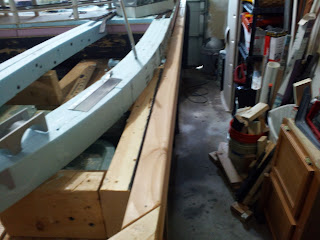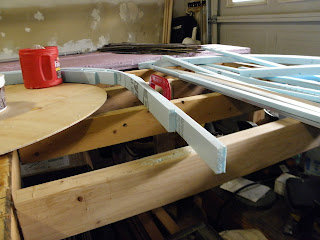I started this morning around 9:30. Spent a bit of time at Harrowgate adding the "extension". With 2/4 added to the benchwork I added 1 1/2" to the layout on that side. Not much, but enough. I then mucked about with the bridges awhile, experimenting with cutting out the arches in the foam core of the spline...
 |
| Layout Extension Harrowgate/Helix |
 |
| Layout Extension Curved Bridge |
 |
| "experimenting with cutting out the arches" |
Next I moved onto the helix and temporarily installed the top two levels. I need the approach level in place so I can move on to the next step. Laying out the mainline from the top down...
 |
| Helix from Harrowgate |
The center of action at Tunnel Hill is the helper loop. All those "snappers", as Pennsy called them, have to be facing forward to head back down the hill. The rules limit their speed while in reverse, while right way round they can do the track speed limit on the way down. Anyway, the helper loop also dictates the general track layout in this area, especially the location of the westbound tracks. They are crowded between the helper loop and the Harrowgate area 8" below. The loop has a radius of 16.5". That's rather generous in N scale and it needs to be. The smallest helpers are Class L1s Mikados, but I Class and J class locomotives also get assigned to helper service. These long wheel base locomotives need some run to come about...
 |
| Tunnel Hill Helper Loop with Radius Gage |
The westbound tracks run around the loop with the inner track at about an 18" radius. More than that and they would overhang the river scene below. As it is there's only about 3" horizontal distance between the two. I have to fit a mountainside in there somewhere...
 |
| "3" horizontal distance between the two" |
After locating the loop and the westbound main I laid out the eastbound tracks...I moved the "radius gage" I had used for the loop and used it to lay out a 18" radius curve though the New Portage Tunnel...
 |
| Eastbound at New Portage Tunnel |
I then added the tracks thru the twin tunnels from Sugar Hill. I had to work both sides on the layout. It's only a two foot reach, but sometimes it's easier to reach from the "wrong" side. It took a bit of adjustment, but I managed to get all those separate tracks to flow together. It came out better than I hoped...
 |
| Sugar Furnace |
So far it's been pretty straight forward laying out the splines. They have all been one or two tracks. At SF tower they all come together. The mainline is four tracks of curving right of way from Remington all the way into Keystone. Laying out a curved spline for four tracks is like herding cats. No other way to describe it. You are juggling eight foam strips. They all have different lengths because of staggered joints, and eight different radii. The ends are all over the place. You are curving, clamping (conventioal and screws), moving tools, supplies, bolt buckets and everything else as you go along trying to maintain the minimum radius. To enhance the fun, sometimes you can get the proper radius until you work further than the curve. The direction and radius of the following curve affects the one you actually are trying to layout. The work goes extremely fast, if only because you are try to keep up with the serpent growing across the garage. Because the spline becomes one huge assembly whatever I do at Kittanning may effect the radius at McCains (or even Reminigton). At the same time, adjustments are a piece of cake to make. The spline flexes into whateve radius curve you want, but only if you don't fasten the strips together. They have to be able to move independently at the same time you need them to be one assembly. It's a great deal of fun, nothing quite like it and all that sort of thing. All of the curves in the photos below had to be laid out almost simultaneously. At lest it felt like it...
 |
| McCains Curve |
 |
| Kittanning Curve |
 |
| McGarveys Curve |
The awesome thing for me is how the curves flow into each other. I've read this is how spline roadbed works in general, not matter what it's made from. You may be able to see in the photos that each curve eases in to the next. They do. All of the curves, with the possible exception of the helper loop have easements. I didn't plan for them, they just happen...
 |
| Kittaning as Viewed From MG Tower |
I stopped at Wikes curve the last(or first if your heading west) curve before BO tower. I ran out of foam strips. Some of the strips I cut from my first sheet were not the proper size. If I had cut them correctly I would have had more than enough to finish the mainline all the way to Llyswen Yards...
 |
| Wikes Curve Just a Few Feet From BO Tower |
That's about it for today. I may have things to do this weekend but when I'm back to work the permanent construction begins. Once the spline is built and glue dries, I create the grade up The Hill.
Regards,
Frank Musick
Chief Cook and Bottle Washer
 |
| Allegheny Eastern Railroad |















No comments:
Post a Comment